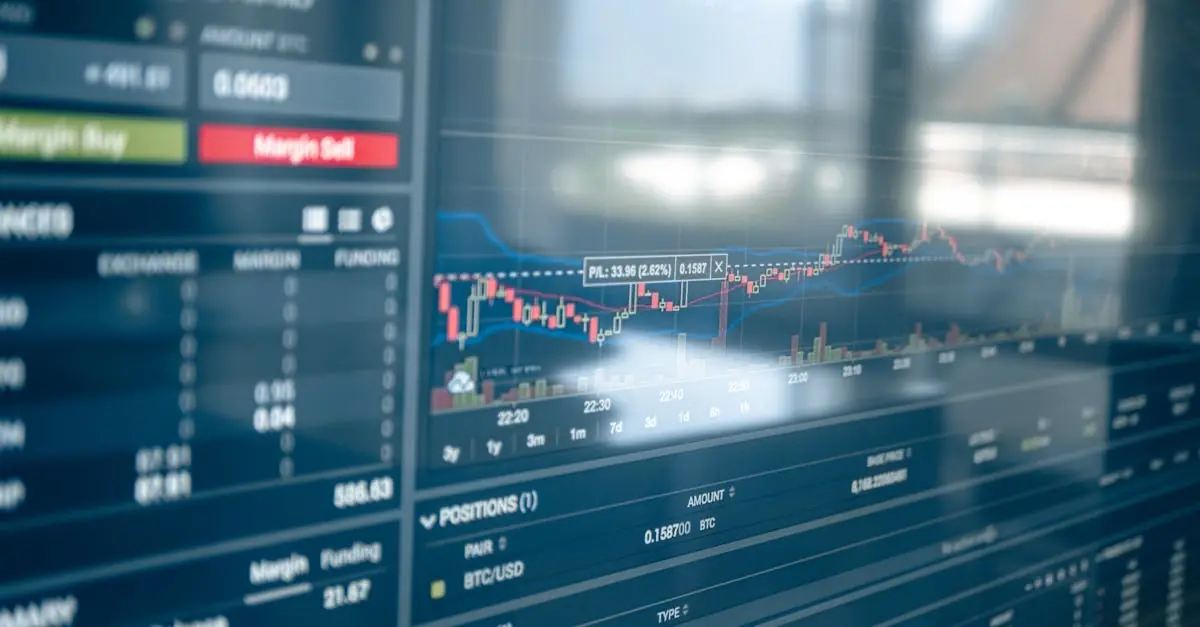In the fast-paced world of cryptocurrencies, understanding the market can feel like trying to read hieroglyphics while blindfolded. But fear not! Crypto technical analysis is here to save the day, turning confusion into clarity. This powerful tool helps traders decipher price movements and trends, making sense of the seemingly chaotic crypto landscape.
Table of Contents
ToggleUnderstanding Crypto Technical Analysis
Crypto technical analysis involves using historical price data and trading volumes to predict future price movements. This method allows traders to interpret market sentiment and identify potential buying or selling opportunities.
Key Concepts and Terminology
Charts display price movements, trending patterns, and trading volumes. Candlestick charts reveal the opening, closing, high, and low prices in a visual format. Indicators such as moving averages smooth price data, providing clearer trends. Support and resistance levels indicate price points where shifts are likely to occur. Volume analysis demonstrates the strength of price movements based on the number of transactions. These key concepts and terms form the foundation of effective crypto technical analysis.
Importance in Cryptocurrency Trading
Crypto technical analysis proves essential for traders seeking to make informed decisions. Predicting market trends saves time by enhancing strategy development. By relying on data rather than emotions, traders can minimize impulsive reactions. Identifying patterns and signals assists in optimizing entry and exit points. Utilizing these insights enables traders to manage risk effectively while maximizing profit potential. Accurate technical analysis contributes to a disciplined trading approach, vital in the volatile cryptocurrency market.
Tools for Crypto Technical Analysis
Crypto technical analysis relies on specific tools to interpret market data effectively. These tools enhance traders’ abilities to make informed decisions in a volatile environment.
Charting Platforms
Charting platforms play a crucial role in the trading process. They allow users to visualize historical price movements and current trends. Popular platforms include TradingView, Coinigy, and CryptoCompare. Each of these platforms offers advanced charting capabilities, enabling traders to customize indicators and time frames. Many of them also provide community features to share insights with fellow traders. Integrating various chart types, such as candlestick or line charts, enhances understanding of price action. Accessibility across devices allows traders to analyze data on the go.
Indicators and Metrics
Indicators and metrics are essential for thorough analysis. Traders often utilize Moving Averages, Relative Strength Index (RSI), and MACD for insights into market trends. Moving Averages smooth out price data to identify the direction of the trend. RSI gauges momentum, indicating overbought or oversold conditions. MACD serves as a momentum oscillator, helping traders identify potential buy or sell signals. Each tool has distinct advantages that provide a comprehensive view of market conditions. Effectively combining these indicators improves the accuracy of predictive models, fostering better decision-making.
Common Techniques in Crypto Technical Analysis
Crypto technical analysis employs various methods to assess price movements and market trends. Understanding these techniques allows traders to make more informed decisions.
Trend Analysis
Trend analysis identifies the general direction of cryptocurrency prices over a specific timeframe. Traders often use trend lines to illustrate upward, downward, or sideways momentum. Recognizing these trends can guide decision-making, whether to enter or exit a trade. Short-term traders typically focus on smaller timeframes, while long-term investors may analyze weekly or monthly trends. Utilizing tools like moving averages helps smooth out price fluctuations and reveals the underlying trend more clearly.
Support and Resistance Levels
Support and resistance levels are crucial for understanding price behavior. Support refers to a price point where buying interest strengthens, preventing further declines. On the other hand, resistance signifies a price level where selling interest intensifies, hindering further increases. Traders often plot these levels on charts, which serve to inform their buying or selling decisions. When prices approach support, traders expect a potential rebound. Conversely, when prices near resistance, they anticipate possible reversals. Identifying these levels enhances traders’ ability to predict market movements and manage risk effectively.
Challenges in Crypto Technical Analysis
Crypto technical analysis faces significant challenges that can impact traders’ ability to make informed decisions. One major hurdle comes from market volatility.
Market Volatility
Market volatility significantly impairs the reliability of technical analysis. Cryptocurrencies often exhibit rapid price swings due to external factors, such as regulatory news or market sentiment shifts. These unpredictable movements can distort trends, making it challenging for traders to rely on historical data. Price fluctuations can occur within minutes, affecting the accuracy of indicators like moving averages. This heightened volatility demands constant vigilance from traders, as strategies that work in stable markets may not hold in turbulent conditions.
Psychological Factors
Psychological factors also complicate crypto technical analysis. Traders often experience emotional responses to market changes, leading to impulsive decisions. Fear of missing out (FOMO) may prompt traders to enter positions without solid analysis, while fear of loss can lead to premature exit points. Such behavioral tendencies can result in deviations from intended strategies, affecting long-term profitability. Recognizing these psychological influences is crucial, as maintaining a disciplined approach can help mitigate adverse effects and enhance trading effectiveness in challenging environments.
Mastering crypto technical analysis is essential for anyone looking to thrive in the unpredictable world of cryptocurrency trading. By leveraging historical price data and utilizing key tools and indicators, traders can gain valuable insights into market trends and sentiment. This knowledge empowers them to make informed decisions and develop effective strategies.
While challenges like market volatility and psychological factors persist, a disciplined approach can significantly enhance trading outcomes. As traders become more adept at interpreting market signals and applying technical analysis techniques, they position themselves to navigate the complexities of the crypto landscape with greater confidence and success. Embracing this analytical framework is a pivotal step toward achieving trading goals in an ever-evolving market.





